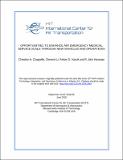| dc.description.abstract | Air Emergency Medical Service (Air EMS) provides unique and important medical trans- port capabilities to society. Air EMS can move patients or live organs more rapidly than surface modes over long distances or congested areas. Air EMS also provides unparalleled access to accident scenes in regions where surface transportation is compromised such as in the backcountry or during disaster scenarios. However, despite these unique capabilities, Air EMS is currently provided to only a small minority of the most critical medical cases. This is due to the high historical cost and risk of airborne operations. Air EMS costs are driven primarily by the high level of availability required of these services and their low utilization. The elevated accident rate compared to other forms of aviation is in large part due to the operation of these services to and from off-field landing areas with unmarked and perhaps un- known obstacles. This research investigates opportunities to increase the number of Air EMS operations provided in a region by reducing the cost per operation and increasing the level of care. Significant recent investments in Urban Air Mobility (UAM) systems are maturing a new class of electric aircraft and automation technologies that may provide benefits to Air EMS operations. Furthermore, opportunities to deploy Air EMS assets as part of a UAM system to increase utilization and reduce costs through revenue management are also reviewed. Finally, potential pathways to leverage Air EMS as a proving ground and forcing function to overcome constraints in air traffic control and community acceptance for broader UAM services are discussed. The results of this study suggest that near-term electric aircraft are not expected to meet the requirements of the Air EMS mission and also provide little cost reduction potential for the industry. However, new operational models that leverage UAM markets and airline rev- enue management systems show promise to enhance Air EMS scale. Finally, flight automation technologies in development for UAM aircraft show potential to increase Air EMS safety. | en_US |
